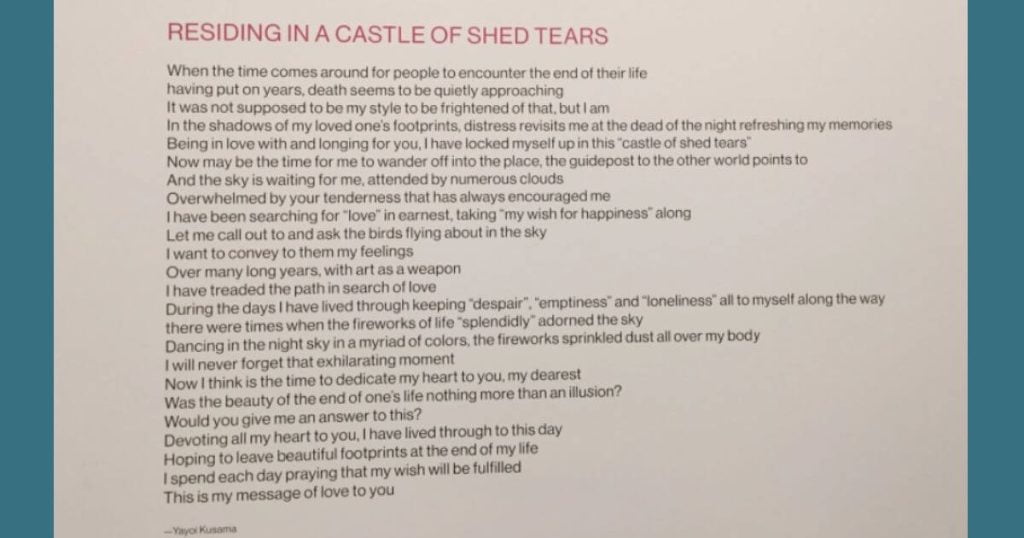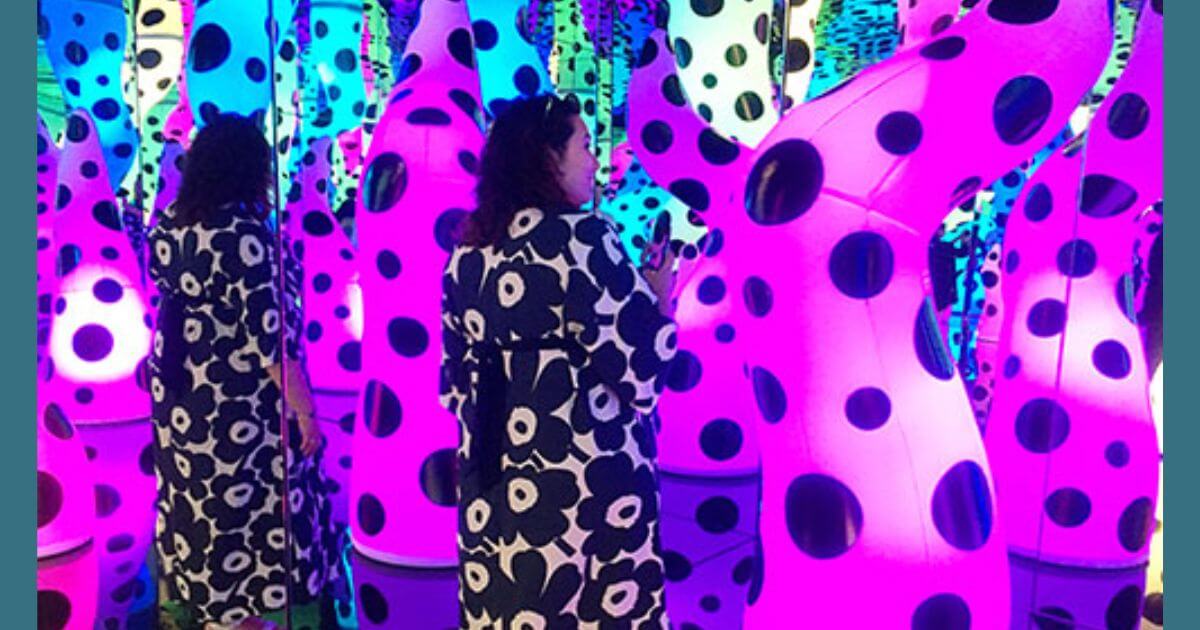As we immerse ourselves in the world of art, we come across pieces that leave us in awe. One such work is the Infinity Mirrored Room – Love is Calling by Yayoi Kusama. This installation art piece has garnered immense popularity and is one of the most sought-after exhibits in contemporary art. In this article, we delve into the world of Yayoi Kusama poem and her masterpiece, and Love is Calling, exploring the artist’s life, her art, and the significance of this piece. We aim to provide an in-depth analysis of the work and its cultural and historical context.
Who is Yayoi Kusama?
Yayoi Kusama is a Japanese contemporary artist born in 1929 in Matsumoto, Nagano. Kusama’s art characterizes as using bright colors, repetition, and patterns. She has worked with various mediums, including painting, sculpture, and installation art.
Kusama’s art influence with her experiences growing up in Japan during World War II. Her father was abusive, and her mother discouraged her from pursuing art. Despite these challenges, Kusama moved to the United States in 1957, where she succeeded in the art world. Yayoi Kusama is considered one of our time’s most influential contemporary artists.
What is Infinity Mirrored Room – Love is Calling?
Love is Calling is an installation art piece by Yayoi Kusama in 2013. The work is part of her larger series of Infinity Mirror Rooms, which consists of small rooms lined with mirrors and filled with various objects. The room in Love is Calling is entirely mirrored. It is creating an illusion of infinite space. The floor covers in red, polka-dotted material, and the walls are adorned with Kusama’s signature tentacle-like forms, which glow in neon colors.
The space fills with hanging inflatable sculptures covered in Kusama’s signature polka dots, creating a feeling of submerging in an area. The sculptures also have audio recordings of Kusama reciting a poem in Japanese, adding another layer of sensory experience to the piece. Read about Neo Pop Art.
The significance of Love is Calling.
Love is Calling is a representation of Yayoi Kusama unique vision. The work reflects her life experiences, struggles with mental health, and fascination with infinity.
For Kusama, infinity represents an escape from the limitations of her own life and a way to transcend her physical body. Mirrors in the installation create an illusion of infinite space, further emphasizing Kusama’s fascination with infinity.
The polka dots used in the piece also have a deep significance for Kusama. The dots represent the idea of the infinite repetition of life and how we are all interconnected in this endless cycle.
Love is Calling has garnered immense famous since its creation, becoming a symbol of current art. The piece shows in galleries and museums worldwide. It is including the Museum of Fine Arts in Houston and the David Zwirner Gallery in New York.
Love is Calling by Yayoi Kusama Poem
It is worth noting that Yayoi Kusama is also a poet in addition to being an artist and has recently writes a poem about the COVID-19 pandemic titled “A Message from Heaven,” in which she commands the virus to “disappear from this earth”. However, her poetry relates to the “LOVE IS CALLING” exhibit and is a separate work by the artist.
In April 2020, Yayoi Kusama released a poem about the COVID-19 pandemic, expressing hope and unity in the face of the crisis. In another poem published in April 2022, Kusama calls for love and healing amid the pandemic.
Residing in a Castle of Shed Tears
“Residing in a Castle of Shed Tears” is a love poem writes and recites by Japanese artist Yayoi Kusama. The poem explores themes of life and death and expresses Kusama’s hope to spread a message of love through her art. The poem features in various exhibitions, including Kusama’s “Love is Calling” exhibit, which includes soft sculptures that change colors as Kusama’s voice recites the poem in Japanese.
The poem’s title in English translates to “Residing in a Castle of Shed Tears” and may reference Kusama’s tears shed while trying to convince her parents to abandon their insistence. The poem describes as poignant and appears in multiple exhibitions across the world. It expresses Kusama’s love for another person and the pain of being separated from them. The verse interpretes as representing the power of love and the inevitable of death.

Critics
Kusama’s use of repetition in her art and poetry is also notable. In “Residing in a Castle of Shed Tears,” she repeats the phrase “in love with and longing for you,”. It adds to the poem’s emotional impact. Similarly, Kusama often uses repetitive patterns and shapes in her art to create a sense of infinity and continuity.
Kusama’s art has garner attention and critical acclaim over the years. Her unique style and message continue to inspire artists and art lovers worldwide. Her poem “Residing in a Castle of Shed Tears” is one example of her experiences. She struggles have influenced her art and made it more meaningful and powerful.
Reference:
http://artsandculturetx.com/meditations-on-love-art-and-life-yayoi-kusama-at-the-mfah/



